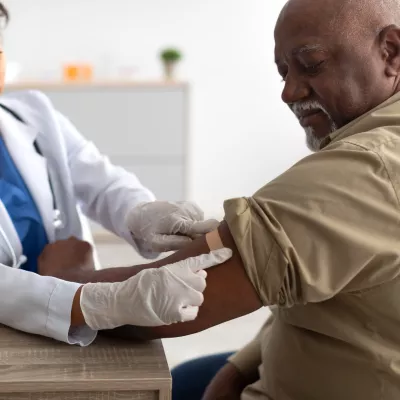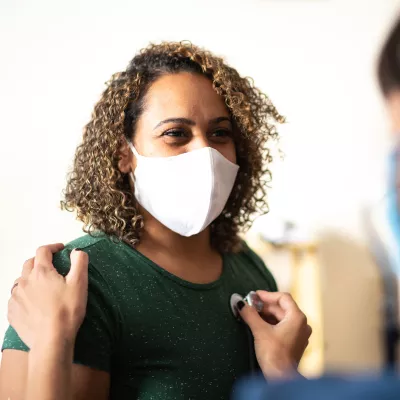- AdventHealth

Choose the health content that’s right for you, and get it delivered right in your inbox.
Did you know that humans breathe in about 11,000 liters of air a day? Breath is life, and here at AdventHealth, we’re all about keeping you healthy in body, mind and spirit. Having healthy lungs is a foundation for a healthy you.
We’ll explain the process of how your lungs work, how to keep them healthy and warning signs that you should seek pulmonary care. So, take a cleansing breath of fresh air, feel your lungs expand — and read on.
Breathe In, Breathe Out
Your lungs, a pair of organs in your chest, are responsible for moving air in and out of your body. When you breathe in, air enters your lungs and life-giving oxygen moves from your lungs into your blood. While this is happening, the waste gas carbon dioxide moves from your blood to the lungs so it can be breathed out. Your brain controls how fast or slow you breathe by sensing how much oxygen your body needs and how much carbon dioxide should be expelled.
Parts of the Respiratory System
Along with your lungs, your respiratory system is made up of different parts that work together to help you breathe. First, we’ll talk about the airways, which consist of:
- Mouth: Air can enter through the mouth
- Nose: The preferred entrance for outside air to enter into the respiratory system
- Sinuses: Hollow spaces in the bones of your head above and below your eyes that are connected to your nose by small openings. Sinuses help regulate the temperature and humidity of inhaled air
- Throat: Collects incoming air from your nose and mouth then passes it down to the windpipe (trachea)
- Windpipe: The passage leading from your throat to your lungs
Now that you know about the airways of the respiratory system, here are the parts that make up your lungs.
Each lung is divided into lobes, or sections. The left lung has two lobes and the right lung has three. Each lobe is like a balloon filled with sponge-like tissue. Air moves in and out through one opening, a branch of the bronchial tube. The bronchial tubes are lined with very small hairs called cilia that move like waves. That carries the mucus up and out into your throat, which is either coughed up or swallowed.
Keeping Your Lungs Healthy
You can keep your lungs healthy by taking care of yourself and making positive lifestyles choices.
No Smoking
Choosing not to smoke, or quitting if you do, is critical for healthy lungs. Smoking is the leading cause of lung cancer, making up about 80% of all lung cancers. You can reduce your lung cancer risk by 70% by quitting smoking. You’ll also be decreasing your risk of other pulmonary illnesses like emphysema and bronchitis.
Get Moving
Getting regular exercise is great for your lungs and your overall health. Your muscles work harder and your body uses more oxygen during exercise. Breathing is increased from around 15 breaths to up to 40 – 60 times per minute during strenuous physical activity. Regular exercise improves your cardio-respiratory health, making it easier for your lungs to keep your heart and muscles supplied with oxygen.
The Air That You Breathe
Consider the quality of the air around you. The air that you breathe on a daily basis has a powerful influence on the health of your lungs. Check the air quality before you leave the house and plan outdoor activities accordingly. Air pollution is not just an outdoor problem. Fireplaces, wood stoves, fumes, mold, pet dander and even some air fresheners and candles can also cause issues for your lungs.
Eat Healthy
Good nutrition is always important for your health. Some foods stand out when it comes to strong, healthy lungs. Antioxidant-rich foods like broccoli, cauliflower, cabbage and kale have been shown to be good for lungs. One study found that people who consume cruciferous vegetables like these had almost half the risk of lung cancer compared to those who consumed the least amount of leafy greens.
When Should You Seek Pulmonary Care?
If you have a newly diagnosed respiratory condition or one that needs consistent care and can’t be controlled by your primary care doctor, please reach out to our specialists who treat the following conditions:
- Asthma
- COPD
- Cystic fibrosis
- Lung cancer
- Lung infection
- Pulmonary embolism
- Sleep apnea
In addition, you may have an undiagnosed pulmonary condition. Make an appointment if you notice the following symptoms or have any of these lifestyle factors:
- Breathing difficulties
- Coughing up blood or mucus
- Difficulty exercising
- Persistent cough
- Smoke regularly
- Unexplained weight loss
If you feel your lungs aren’t as healthy as you’d like them to be, you can breathe easier knowing we are here for you with our world-class team of pulmonologists. Click here to find out more and make an appointment today. You deserve to feel whole in body, mind and spirit.



